
R1-Searcher
R1-searcher: Incentivizing the Search Capability in LLMs via Reinforcement Learning
Stars: 368
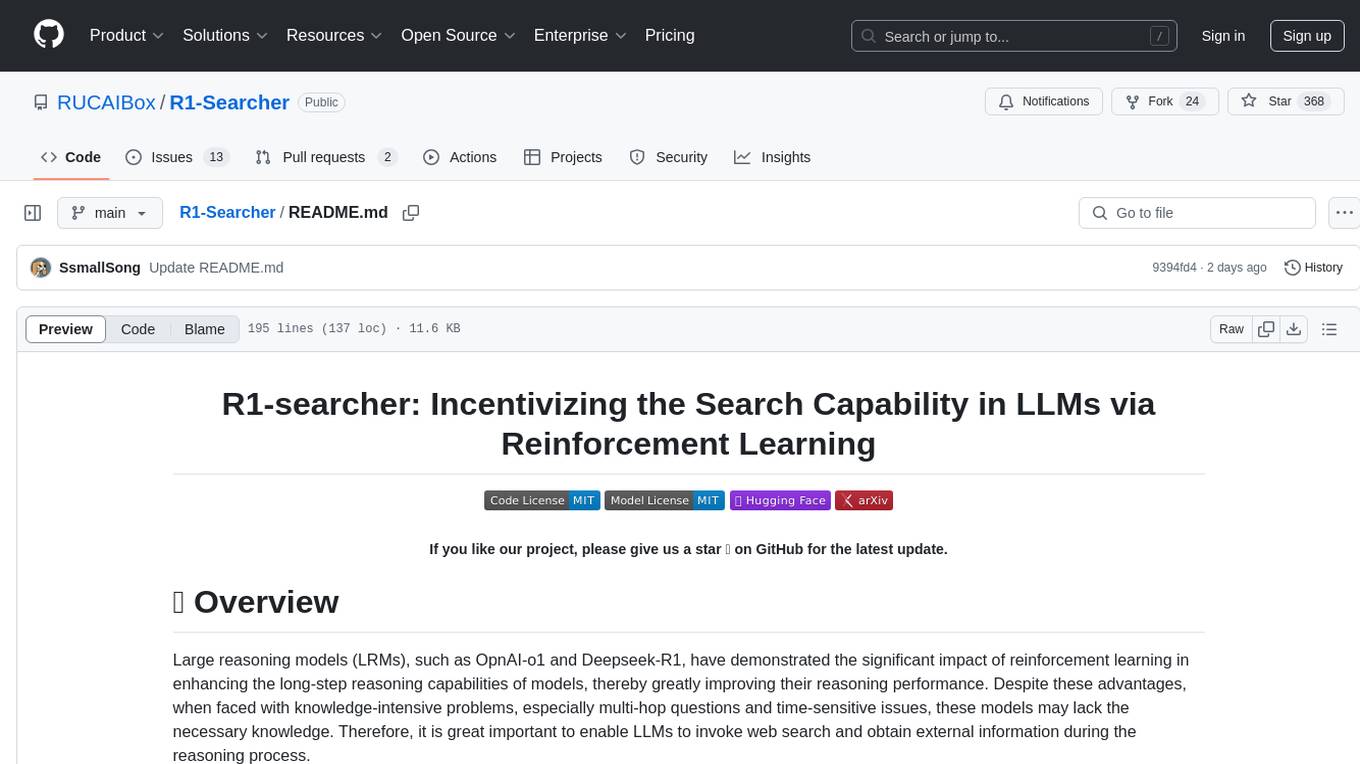
R1-searcher is a tool designed to incentivize the search capability in large reasoning models (LRMs) via reinforcement learning. It enables LRMs to invoke web search and obtain external information during the reasoning process by utilizing a two-stage outcome-supervision reinforcement learning approach. The tool does not require instruction fine-tuning for cold start and is compatible with existing Base LLMs or Chat LLMs. It includes training code, inference code, model checkpoints, and a detailed technical report.
README:
Large reasoning models (LRMs), such as OpnAI-o1 and Deepseek-R1, have demonstrated the significant impact of reinforcement learning in enhancing the long-step reasoning capabilities of models, thereby greatly improving their reasoning performance. Despite these advantages, when faced with knowledge-intensive problems, especially multi-hop questions and time-sensitive issues, these models may lack the necessary knowledge. Therefore, it is great important to enable LLMs to invoke web search and obtain external information during the reasoning process.
We propose R1-searcher, utilizing a two-stage outcome-supervision reinforcement learning approach to enable the model to learn to invoke web search during the reasoning process: first allowing the model to learn how to invoke web search, and then teaching it how to effectively use that search engine. This method does not require any instruction fine-tuning for cold start, and at the same time, it is compatible with existing Base LLMs or Chat LLMs. We open-source the training code, inference code, model checkpoints, and the detailed technical report.
- Arxiv: https://arxiv.org/pdf/2503.05592
- Model:
- Qwen-2.5-7B-Base-RAG-RL: https://huggingface.co/XXsongLALA/Qwen-2.5-7B-base-RAG-RL
- Llama-3.1-8B-Instruct-RAG-RL: https://huggingface.co/XXsongLALA/Llama-3.1-8B-instruct-RAG-RL
- Train-data: https://huggingface.co/datasets/XXsongLALA/RAG-RL-Hotpotqa-with-2wiki
- By relying solely on outcome-supervised reinforcement learning, we can activate the model's intrinsic search capabilities using only the query-answer pair, regardless of whether we are dealing with Base LLMs or Chat LLMs.
- Recent reinforcement learning algorithms, such as GRPO and Reinforce++ both can effectively activate the internal search capabilities of the LLMs.
- There is no requirement for complex prompt engineering or process supervision during training.
- The capability of the Base LLMs largely influences whether the model can directly start training from Zero.
- LongCoT reasoning after RL is an more effectively and efficient test time scaling method than existing tree-search based methods, e.g., Monte Carlo Tree Search.
- By using a local retrieval for RL training, the model can generalize well to other datasets and online searches scenarios.
- The final 7B parameters LLMs achieve the significant performance improvements compared to existing complex method or even close-sourced LLMs (e.g., GPT-4o-mini).
We employ a Two-Stage Reward Guided RL Training approach:
Stage 1: Learn to invoke search with only format-reward.
Stage 2: Learn to solve questions with invoking search with format-reward and answer-reward.
We use only outcome-supervised reinforcement learning for training, so we need to consider two main aspects: (1) the reinforcement learning algorithm, and (2) the design of the reward.
- RL Algorithm: We use Reinforce++ as our RL algorithm. For each questions, we average the rewards of n samples, which stabilizes the training process. For the solution format, we utilize
<think>...</think>tag for thinking, xxx for searching, and<answer>...</answer>for answering,<begin_of_search>...<end_of_search>for invoking search tool and<begin_of_documents>...<end_of_documents>for returned retrieval documents. - Reward Design:In Stage-1, we use the retrieve-reward: if the model performs retrieval and the solution meets the format requirements, 0.5 points are added to the answer reward. In Stage 2, the retrieval requirement is removed and we utilize the F1-based answer-reward. A penalty of 2 points is subtracted from the answer reward if the solution does not meet the format requirements. Detailed implementation, including hyperparameters can be found in our code.
We choose a portion of the training sets from HotpotQA and 2WikiMultiHopQA as our training data. We use Qwen-2.5-7B-Instruct to perform rollouts on the training dataset.
Based on the number of rollouts required to answer a question correctly, we classify the data into three categories: easy (<10 rollouts), medium (10 < and < 20 rollouts), and difficult (>20 rollouts). These categories are then mixed in a specific ratio to form our training data. All of our training data can be found here: https://huggingface.co/datasets/XXsongLALA/RAG-RL-Hotpotqa-with-2wiki.
Following ReARTeR(https://arxiv.org/pdf/2501.07861), we select four representative benchmarks: HotpotQA, 2WikiMultiHopQA, Musique, and Bamboogle.
HotpotQA and 2WikiMultiHopQA are considered in-domain as we use their training-set, while Musique and Bamboogle are classified as out-of-domain, allowing us to assess the generalization capabilities of our model. We randomly sample 500 examples from the development sets of HotpotQA, 2WikiMultiHopQA, and Musique to serve as our test sets. For Bamboogle, we use all of the test set (125 samples) as our test set..
Wikipedia passages serve as the retrieval corpus for all datasets, specifically employing the Wikipedia corpus released by KILT in August 2019. Additionally, due to the recency of the knowledge contained in Bamboogle, we incorporate online web search testing to conduct further evaluations, thereby examining the alignment of our model with online search capabilities.
For the evaluation metrics, we use the ACC_R (Cover-Exect-Match) and ACC_L (LLM-as-Judge).
 As we can see, when using the same LLaMA-3.1-8B-Instruct base model, our method has achieved significant improvements compared to existing methods, even surpassing closed-source models such as GPT-4o-mini. Furthermore, when switching to the more powerful base model, Qwen-2.5-7B-Base, we directly conduct reinforcement learning from scratch. Eventually, we can achieve better results and attain the best performance on all in-domain and out-of-domain datasets, demonstrating the exceptional generalization capabilities of our model.
As we can see, when using the same LLaMA-3.1-8B-Instruct base model, our method has achieved significant improvements compared to existing methods, even surpassing closed-source models such as GPT-4o-mini. Furthermore, when switching to the more powerful base model, Qwen-2.5-7B-Base, we directly conduct reinforcement learning from scratch. Eventually, we can achieve better results and attain the best performance on all in-domain and out-of-domain datasets, demonstrating the exceptional generalization capabilities of our model.
For Bamboogle, we additionally utilize Google for online searches. As we can see, compared to relying solely on a local knowledge base, the incorporation of online search yields superior results, indicating that it is feasible to seamlessly integrate online search capabilities into our model.

Note: the environment is same to STILL-3 (Great work!).
conda create --name r1-searcher python=3.10.16
conda activate r1-searcher
pip install vllm==0.6.5
pip install packaging
pip install ninja
pip install flash-attn --no-build-isolation
pip install deepspeed
pip install accelerate
pip install datasetscd R1-Searcher
## Process wiki only abs
wget -nv --no-check-certificate https://rocketqa.bj.bcebos.com/corpus/nq.tar.gz
tar -zxf nq.tar.gz
rm -rf nq.tar.gz # We only use the title and abs.
## Process wiki full texts
wget http://dl.fbaipublicfiles.com/KILT/kilt_knowledgesource.json
cd R1-Searcher
python wiki_corpus_index_bulid/split_kilt_to_100.py
## Index the tsv file. We recommend splitting the original TSV file into n parts for embedding, otherwise the process will be very slow.
python wiki_corpus_index_bulid/build_corpus_embedding.py --file_path the_tsv_file_path --save_path the_pickle_path --gpu_id 0
python wiki_corpus_index_bulid/build_corpus_idnex.py
cd R1-Searcher
## Ray start
bash scripts/ray_start.sh
## Mount Wikipedia
python train/wiki_corpus_load.py hotpotqa 5004 &
## Start Reward Server
python train/reward_server_qwen_zero.py --data_path data/training_set/stage_2.jsonl --reward_pretrain the_model_path --log_file results/samples/qwen.jsonl --port 1278
## Training
bash scripts/qwen_reinforce_plus_train.sh | tee results/logs/qwen_reinforce_plus_train.txtcd R1-Searcher
## Local Search
## HotpotQA
python train/wiki_corpus_load.py hotpotqa 5004 &
python evaluation/eval_search_loacl.py --gpu_id 0 --temp 0.0 --port 5004 --prompt_type v0 --src_file data/eval_set/hotpotqa_500.jsonl --model_path the_path_to_model
## 2Wiki, Musique, Bamboogle
python train/wiki_corpus_load.py kilt 5005 &
python evaluation/eval_search_loacl.py --gpu_id 0 --temp 0.0 --port 5005 --prompt_type v0 --src_file data/eval_set/bamboogle_500.jsonl --model_path the_path_to_model
## Online Search
## Bamboogle
python evaluation/eval_search_online.py --gpu_id 0 --temp 0.0 --port 5004 --prompt_type v0 --src_file data/eval_set/bamboogle_500.jsonl --model_path the_path_to_model
## Calculate Metric
## Exact Match, Cover Exact Match, F1 Score
python evaluation/metric_calc_rule.py the_path_to_results
## LLM-as-Judge. Remember replace the input file to your own results.
python evaluation/metric_calc_gpt_as_judge.pyPlease kindly cite our report if they are helpful for your research.
@article{R1-searcher,
title={R1-Searcher: Incentivizing the Search Capability in LLMs via Reinforcement Learning},
author={Huatong Song, Jinhao Jiang, Yingqian Min, Jie Chen, Zhipeng Chen, Wayne Xin Zhao, Ji-Rong Wen, Yang Lu, Xu Miu},
url={https://github.com/SsmallSong/R1-searcher},
year={2025}
}
This project is released under the MIT License.
For any questions or feedback, please reach out to us at [email protected].
For Tasks:
Click tags to check more tools for each tasksFor Jobs:
Alternative AI tools for R1-Searcher
Similar Open Source Tools

R1-Searcher
R1-searcher is a tool designed to incentivize the search capability in large reasoning models (LRMs) via reinforcement learning. It enables LRMs to invoke web search and obtain external information during the reasoning process by utilizing a two-stage outcome-supervision reinforcement learning approach. The tool does not require instruction fine-tuning for cold start and is compatible with existing Base LLMs or Chat LLMs. It includes training code, inference code, model checkpoints, and a detailed technical report.
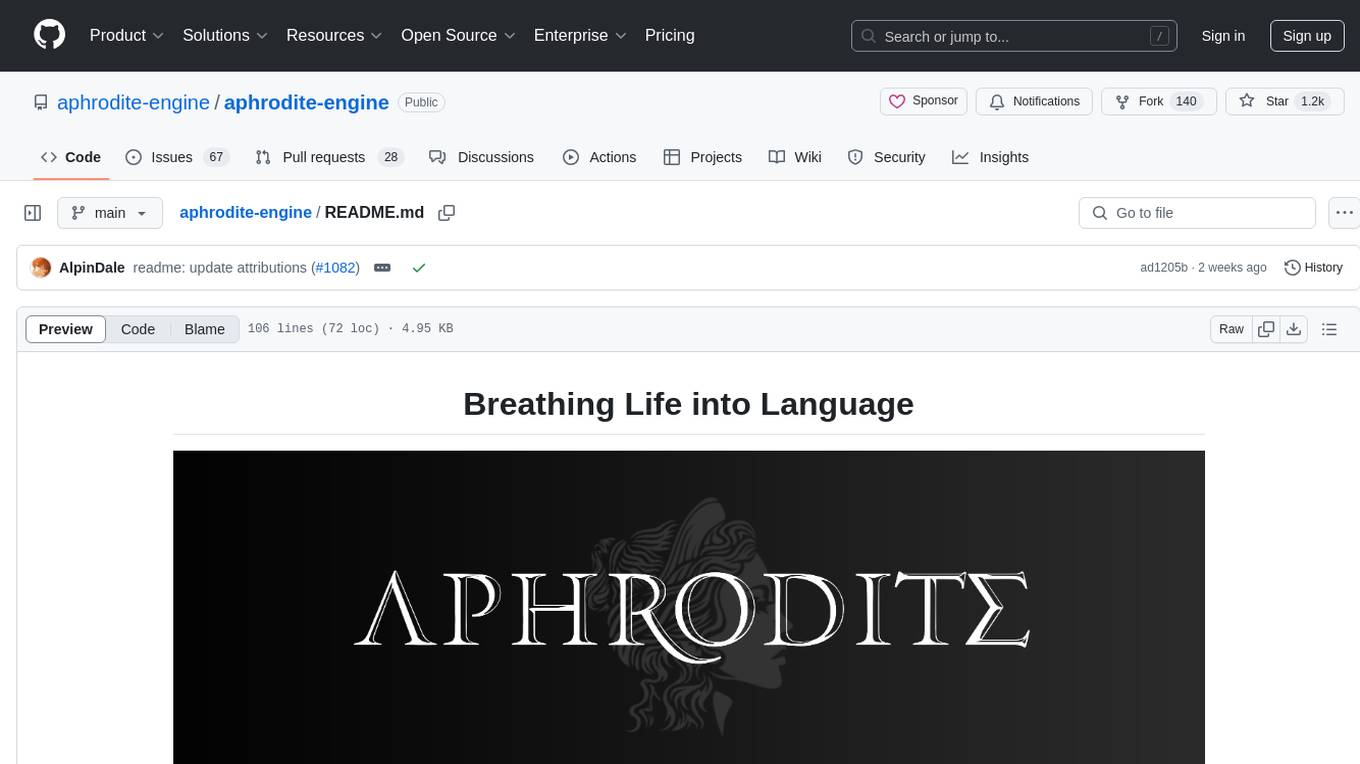
aphrodite-engine
Aphrodite is an inference engine optimized for serving HuggingFace-compatible models at scale. It leverages vLLM's Paged Attention technology to deliver high-performance model inference for multiple concurrent users. The engine supports continuous batching, efficient key/value management, optimized CUDA kernels, quantization support, distributed inference, and modern samplers. It can be easily installed and launched, with Docker support for deployment. Aphrodite requires Linux or Windows OS, Python 3.8 to 3.12, and CUDA >= 11. It is designed to utilize 90% of GPU VRAM but offers options to limit memory usage. Contributors are welcome to enhance the engine.
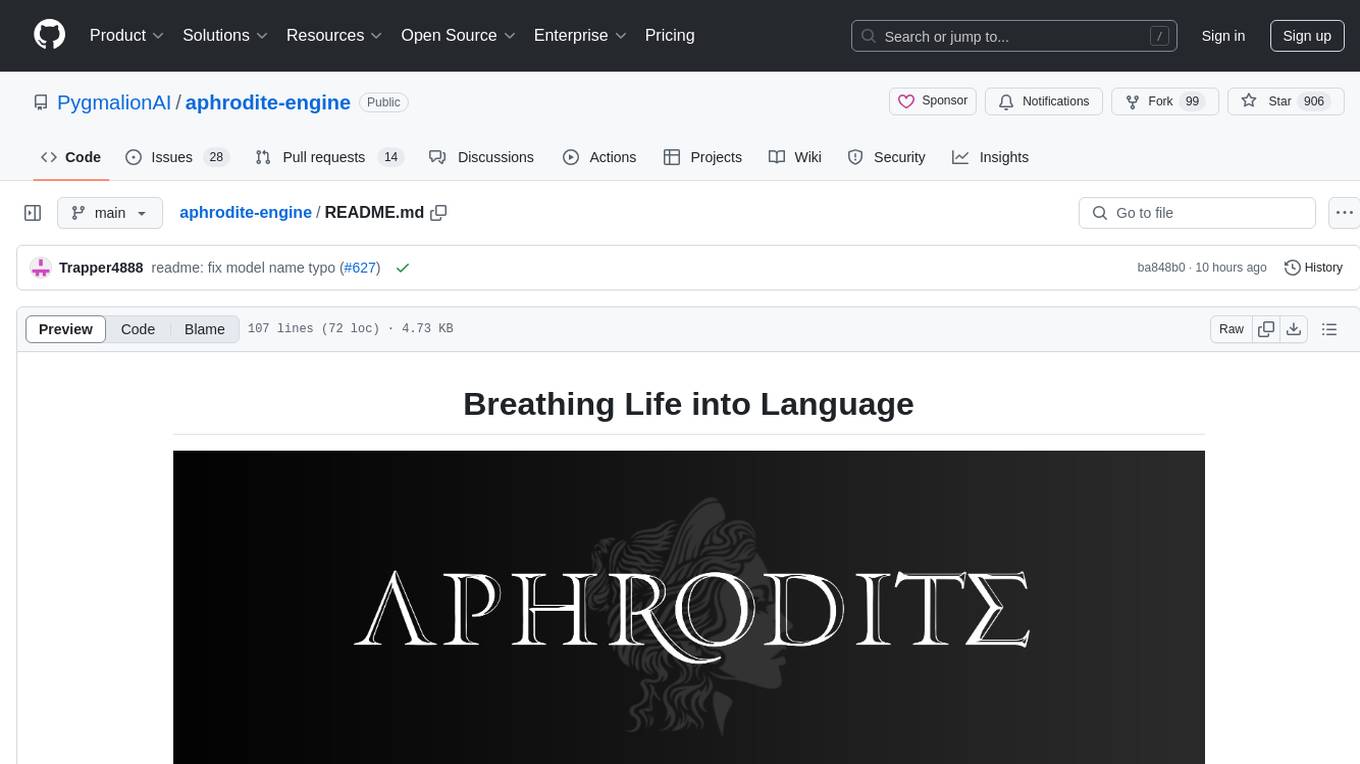
aphrodite-engine
Aphrodite is the official backend engine for PygmalionAI, serving as the inference endpoint for the website. It allows serving Hugging Face-compatible models with fast speeds. Features include continuous batching, efficient K/V management, optimized CUDA kernels, quantization support, distributed inference, and 8-bit KV Cache. The engine requires Linux OS and Python 3.8 to 3.12, with CUDA >= 11 for build requirements. It supports various GPUs, CPUs, TPUs, and Inferentia. Users can limit GPU memory utilization and access full commands via CLI.
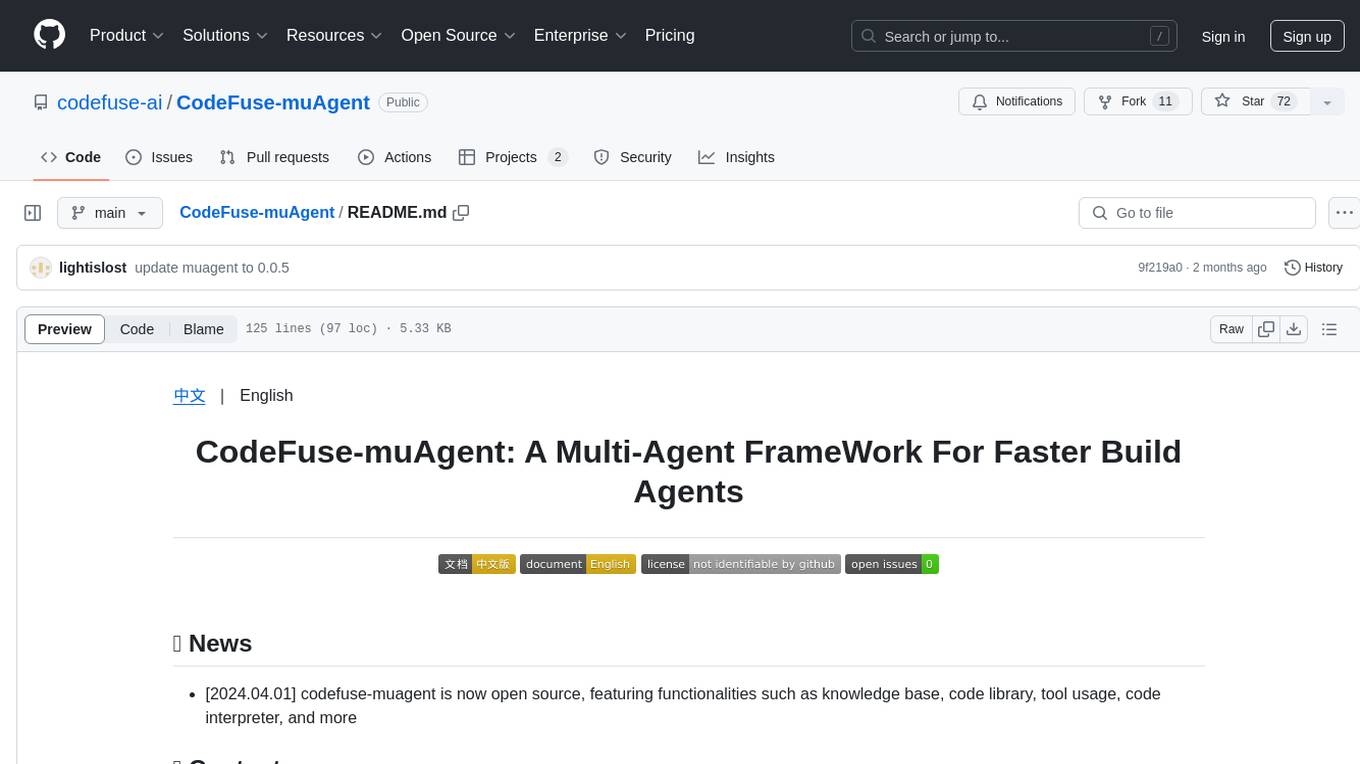
CodeFuse-muAgent
CodeFuse-muAgent is a Multi-Agent framework designed to streamline Standard Operating Procedure (SOP) orchestration for agents. It integrates toolkits, code libraries, knowledge bases, and sandbox environments for rapid construction of complex Multi-Agent interactive applications. The framework enables efficient execution and handling of multi-layered and multi-dimensional tasks.
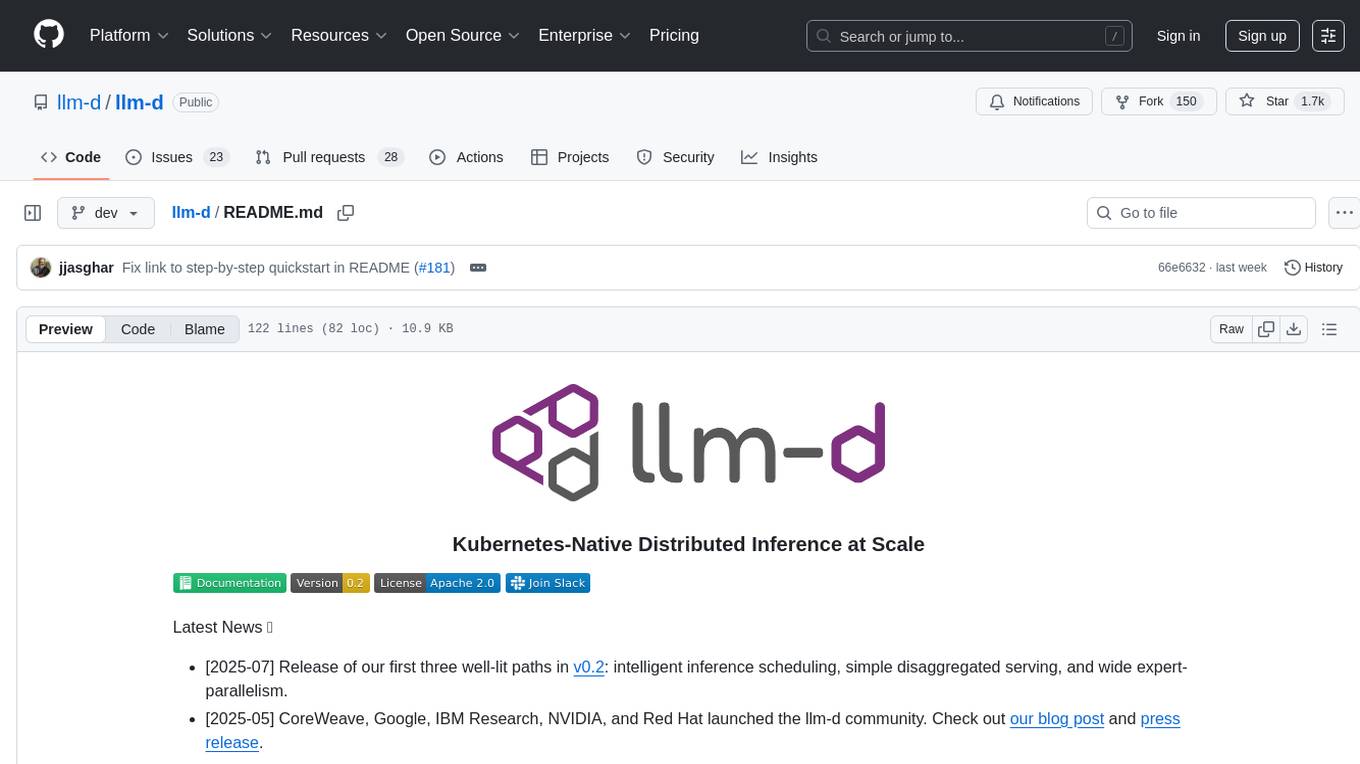
llm-d
LLM-D is a machine learning model for sentiment analysis. It is designed to classify text data into positive, negative, or neutral sentiment categories. The model is trained on a large dataset of labeled text samples and uses natural language processing techniques to analyze and predict sentiment in new text inputs. LLM-D is a powerful tool for businesses and researchers looking to understand customer feedback, social media sentiment, and other text data sources. It can be easily integrated into existing applications or used as a standalone tool for sentiment analysis tasks.

langchain4j
LangChain for Java simplifies integrating Large Language Models (LLMs) into Java applications by offering unified APIs for various LLM providers and embedding stores. It provides a comprehensive toolbox with tools for prompt templating, chat memory management, function calling, and high-level patterns like Agents and RAG. The library supports 15+ popular LLM providers and 15+ embedding stores, offering numerous examples to help users quickly start building LLM-powered applications. LangChain4j is a fusion of ideas from various projects and actively incorporates new techniques and integrations to keep users up-to-date. The project is under active development, with core functionality already in place for users to start building LLM-powered apps.
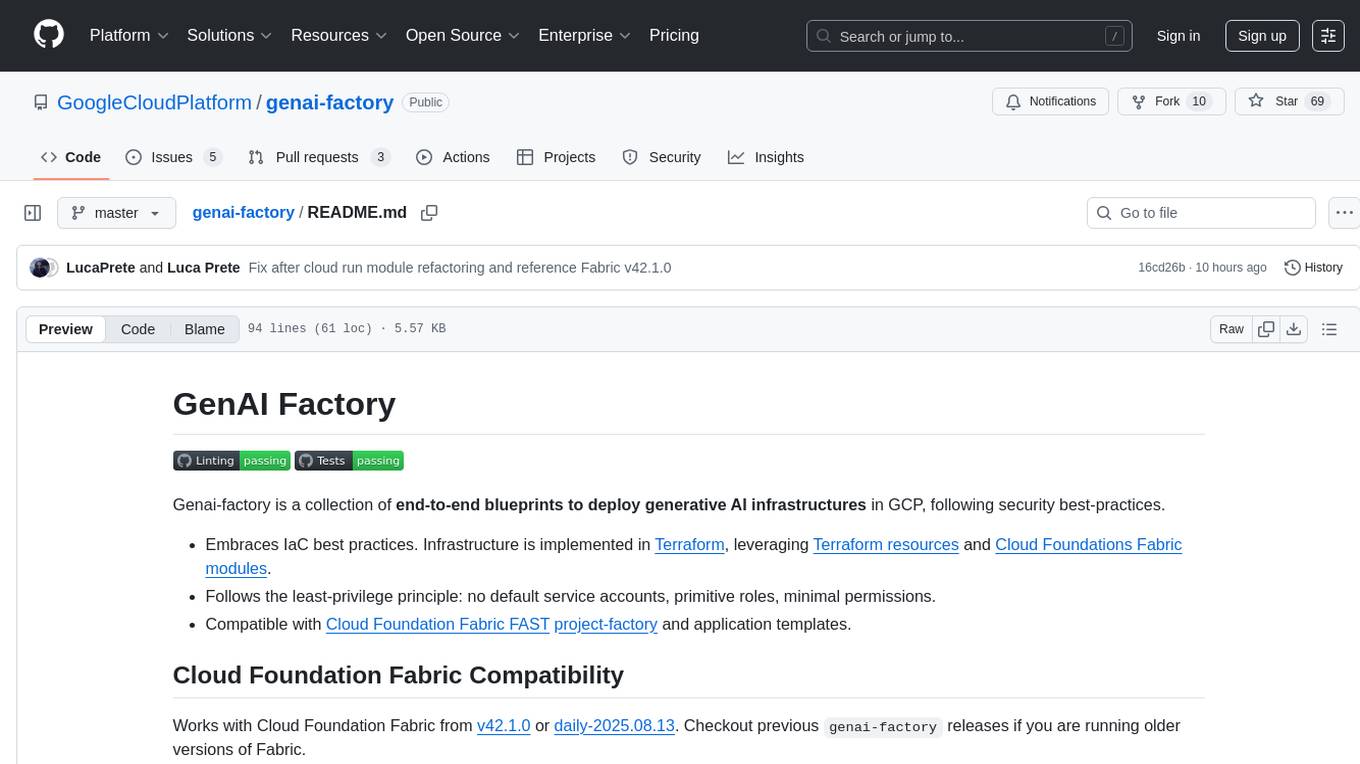
genai-factory
GenAI Factory is a collection of end-to-end blueprints to deploy generative AI infrastructures in Google Cloud Platform (GCP), following security best practices. It embraces Infrastructure as Code (IaC) best practices, implements infrastructure in Terraform, and follows the least-privilege principle. The tool is compatible with Cloud Foundation Fabric FAST project-factory and application templates, allowing users to deploy various AI applications and systems on GCP.
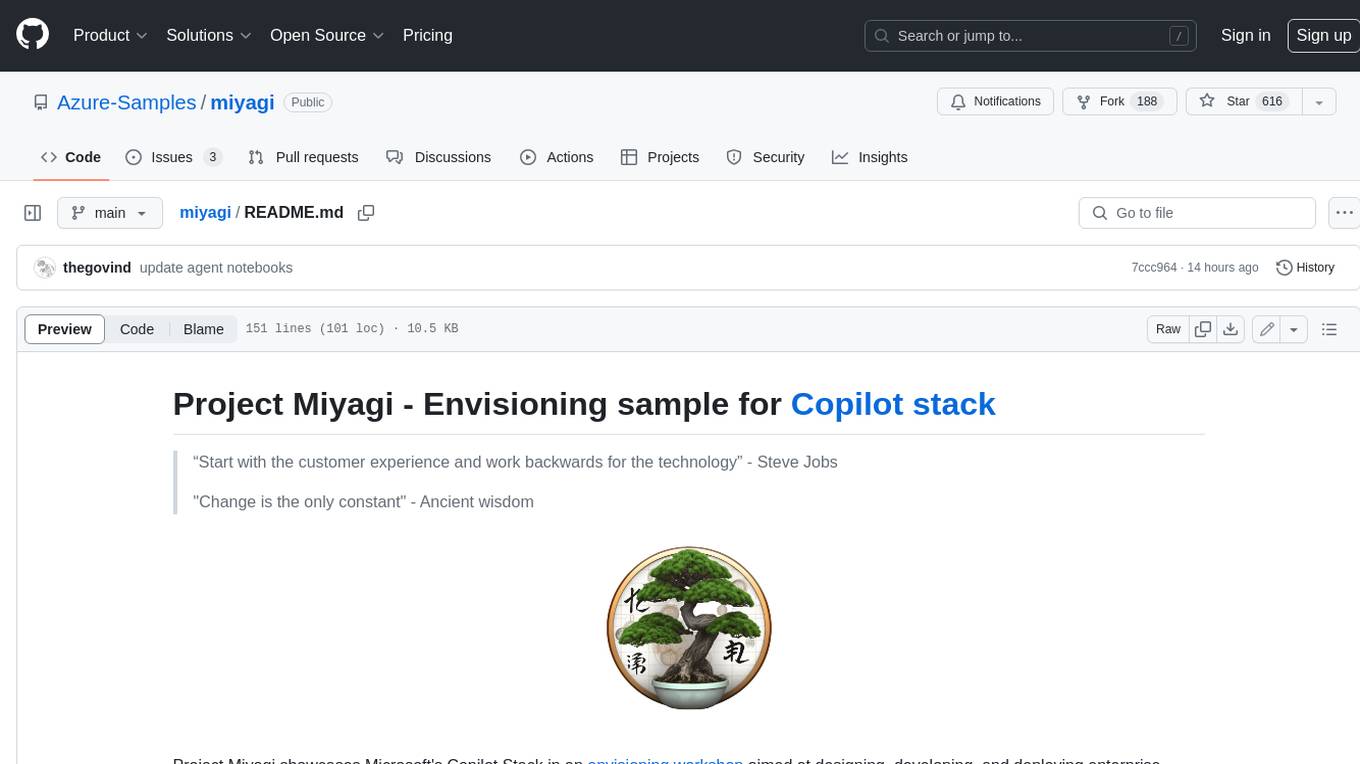
miyagi
Project Miyagi showcases Microsoft's Copilot Stack in an envisioning workshop aimed at designing, developing, and deploying enterprise-grade intelligent apps. By exploring both generative and traditional ML use cases, Miyagi offers an experiential approach to developing AI-infused product experiences that enhance productivity and enable hyper-personalization. Additionally, the workshop introduces traditional software engineers to emerging design patterns in prompt engineering, such as chain-of-thought and retrieval-augmentation, as well as to techniques like vectorization for long-term memory, fine-tuning of OSS models, agent-like orchestration, and plugins or tools for augmenting and grounding LLMs.

ersilia
The Ersilia Model Hub is a unified platform of pre-trained AI/ML models dedicated to infectious and neglected disease research. It offers an open-source, low-code solution that provides seamless access to AI/ML models for drug discovery. Models housed in the hub come from two sources: published models from literature (with due third-party acknowledgment) and custom models developed by the Ersilia team or contributors.

agentUniverse
agentUniverse is a multi-agent framework based on large language models, providing flexible capabilities for building individual agents. It focuses on collaborative pattern components to solve problems in various fields and integrates domain experience. The framework supports LLM model integration and offers various pattern components like PEER and DOE. Users can easily configure models and set up agents for tasks. agentUniverse aims to assist developers and enterprises in constructing domain-expert-level intelligent agents for seamless collaboration.
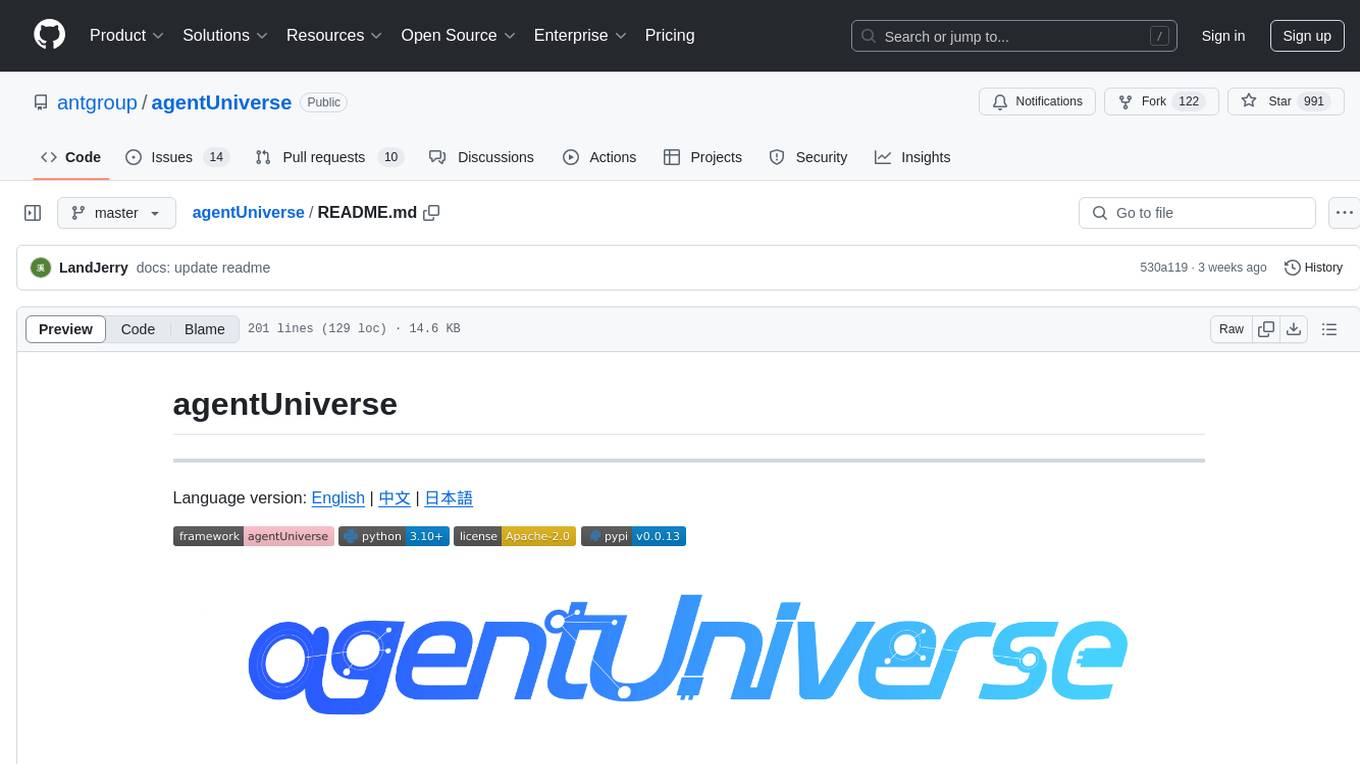
agentUniverse
agentUniverse is a multi-agent framework based on large language models, providing flexible capabilities for building individual agents. It focuses on multi-agent collaborative patterns, integrating domain experience to help agents solve problems in various fields. The framework includes pattern components like PEER and DOE for event interpretation, industry analysis, and financial report generation. It offers features for agent construction, multi-agent collaboration, and domain expertise integration, aiming to create intelligent applications with professional know-how.
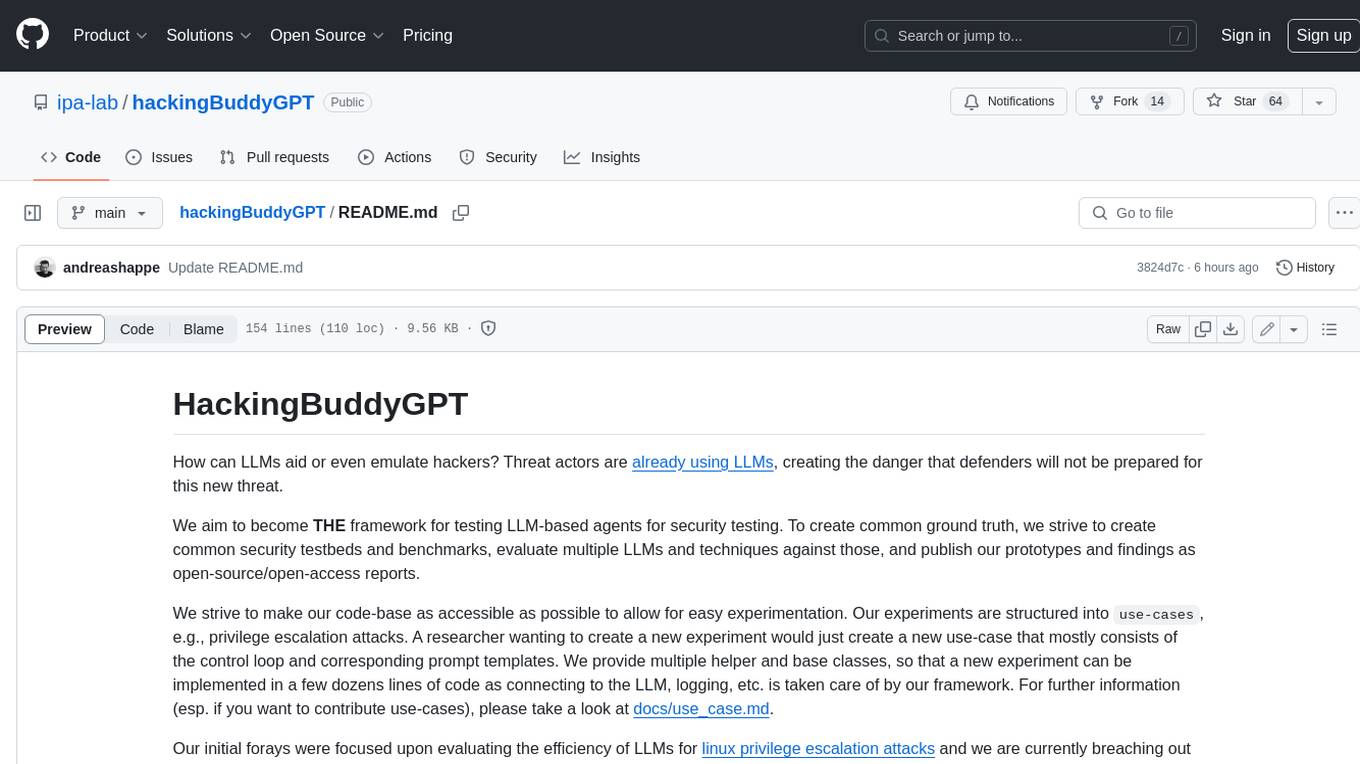
hackingBuddyGPT
hackingBuddyGPT is a framework for testing LLM-based agents for security testing. It aims to create common ground truth by creating common security testbeds and benchmarks, evaluating multiple LLMs and techniques against those, and publishing prototypes and findings as open-source/open-access reports. The initial focus is on evaluating the efficiency of LLMs for Linux privilege escalation attacks, but the framework is being expanded to evaluate the use of LLMs for web penetration-testing and web API testing. hackingBuddyGPT is released as open-source to level the playing field for blue teams against APTs that have access to more sophisticated resources.

Robyn
Robyn is an experimental, semi-automated and open-sourced Marketing Mix Modeling (MMM) package from Meta Marketing Science. It uses various machine learning techniques to define media channel efficiency and effectivity, explore adstock rates and saturation curves. Built for granular datasets with many independent variables, especially suitable for digital and direct response advertisers with rich data sources. Aiming to democratize MMM, make it accessible for advertisers of all sizes, and contribute to the measurement landscape.
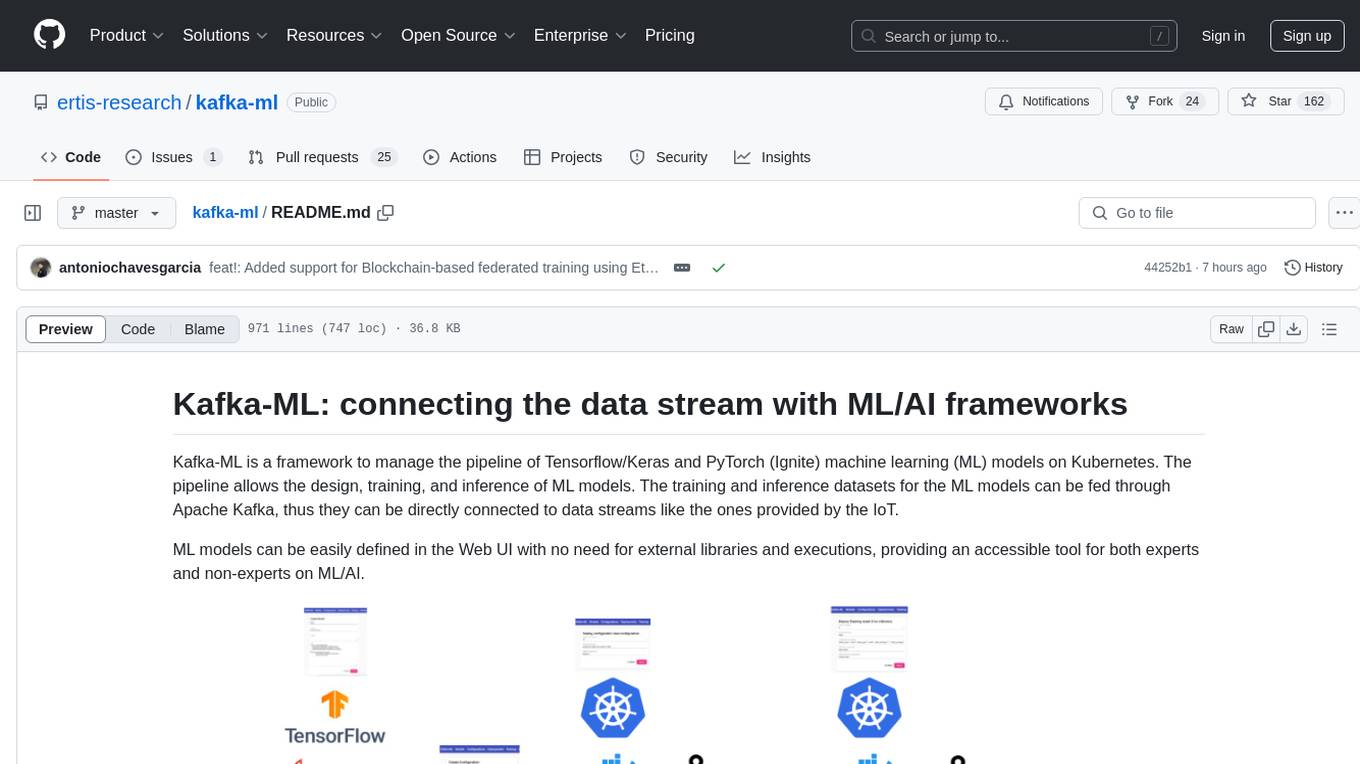
kafka-ml
Kafka-ML is a framework designed to manage the pipeline of Tensorflow/Keras and PyTorch machine learning models on Kubernetes. It enables the design, training, and inference of ML models with datasets fed through Apache Kafka, connecting them directly to data streams like those from IoT devices. The Web UI allows easy definition of ML models without external libraries, catering to both experts and non-experts in ML/AI.
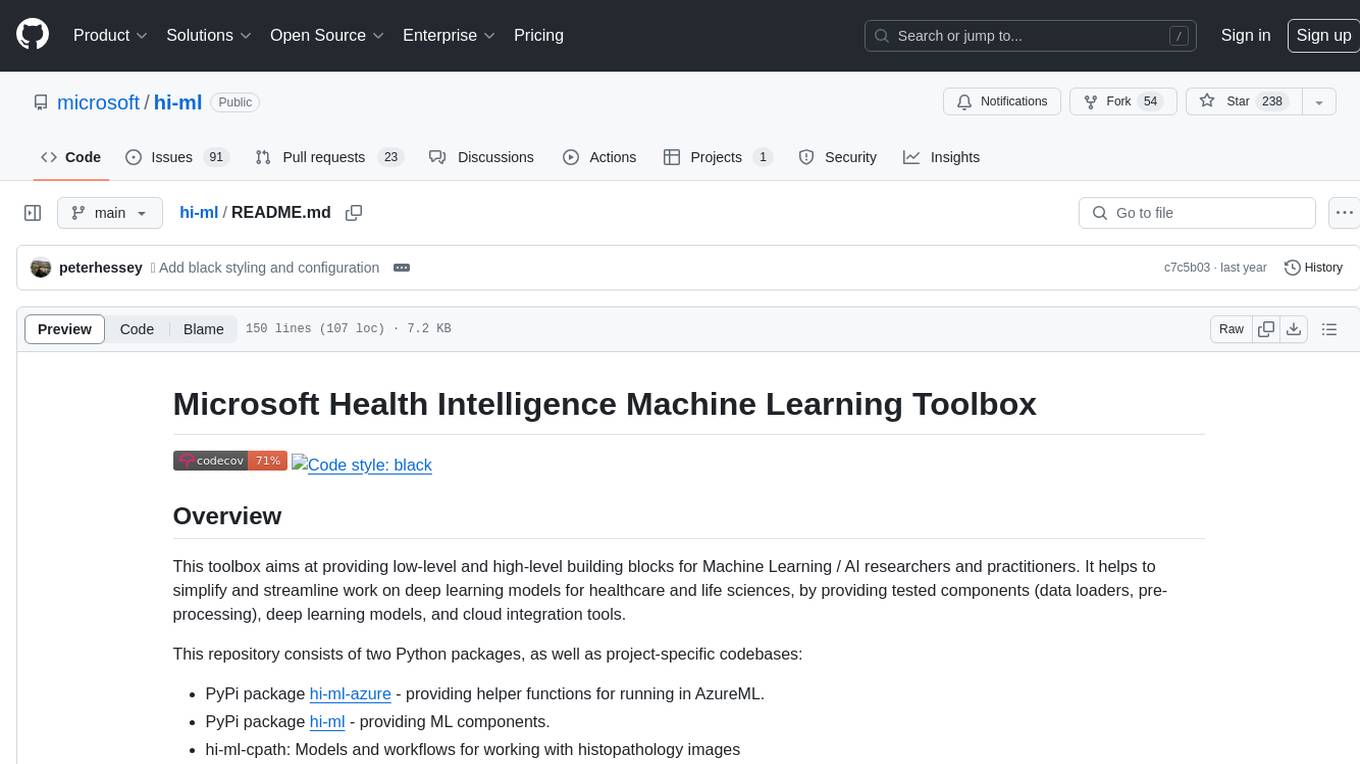
hi-ml
The Microsoft Health Intelligence Machine Learning Toolbox is a repository that provides low-level and high-level building blocks for Machine Learning / AI researchers and practitioners. It simplifies and streamlines work on deep learning models for healthcare and life sciences by offering tested components such as data loaders, pre-processing tools, deep learning models, and cloud integration utilities. The repository includes two Python packages, 'hi-ml-azure' for helper functions in AzureML, 'hi-ml' for ML components, and 'hi-ml-cpath' for models and workflows related to histopathology images.
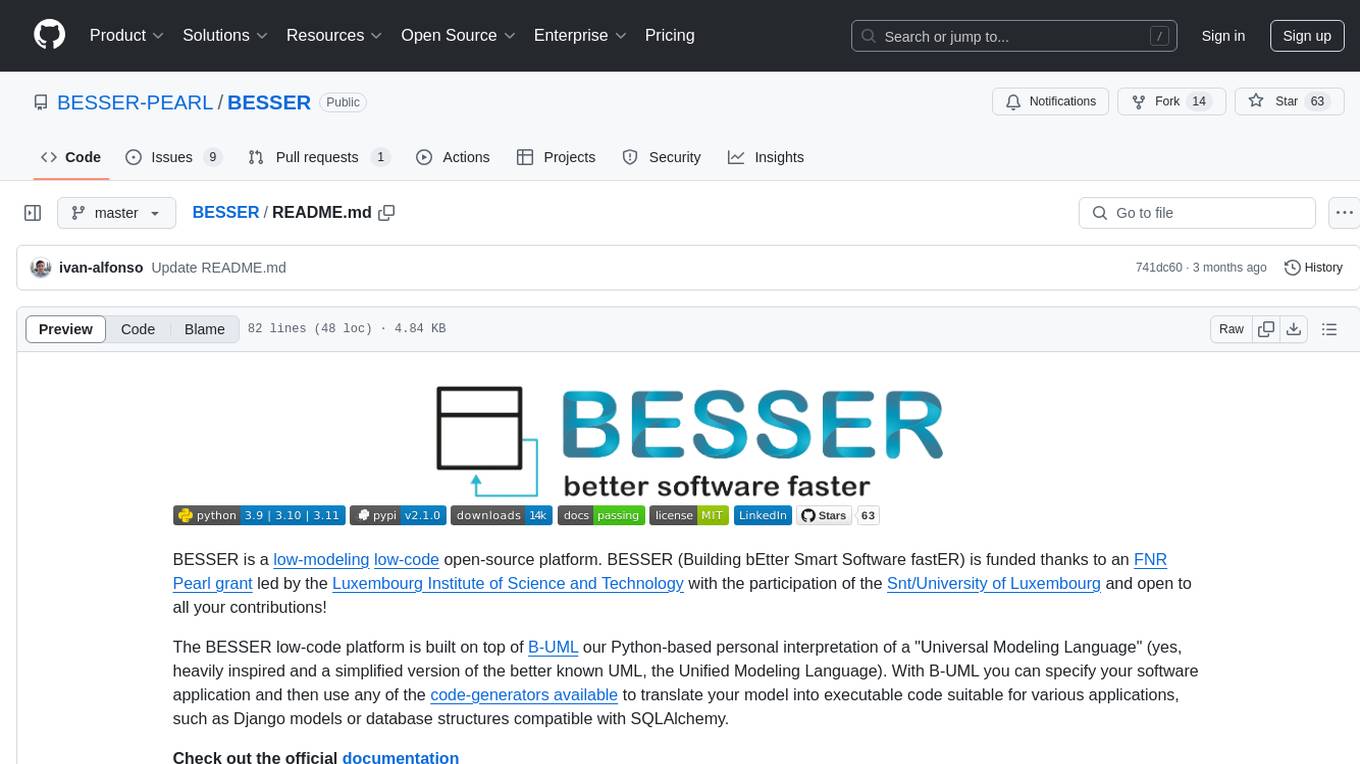
BESSER
BESSER is a low-modeling low-code open-source platform funded by an FNR Pearl grant. It is built on B-UML, a Python-based interpretation of a 'Universal Modeling Language'. Users can specify their software application using B-UML and generate executable code for various applications like Django models or SQLAlchemy-compatible database structures. BESSER is available on PyPi and can be installed with pip. It supports popular Python IDEs and encourages contributions from the community.
For similar tasks
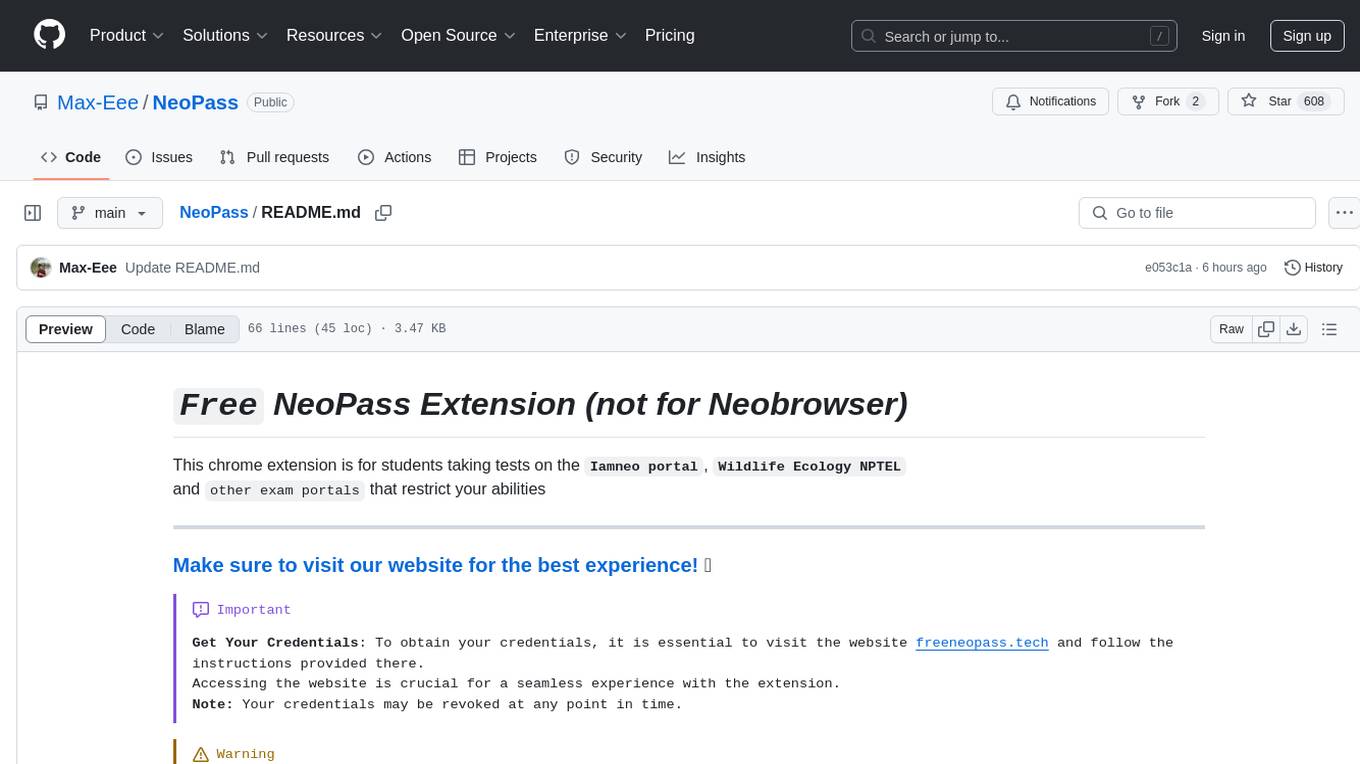
NeoPass
NeoPass is a free Chrome extension designed for students taking tests on exam portals like Iamneo and Wildlife Ecology NPTEL. It provides features such as NPTEL integration, NeoExamShield bypass, AI chatbot with stealth mode, AI search answers/code, MCQ solving, tab switching bypass, pasting when restricted, and remote logout. Users can install the extension by following simple steps and use shortcuts for quick access to features. The tool is intended for educational purposes only and promotes academic integrity.

R1-Searcher
R1-searcher is a tool designed to incentivize the search capability in large reasoning models (LRMs) via reinforcement learning. It enables LRMs to invoke web search and obtain external information during the reasoning process by utilizing a two-stage outcome-supervision reinforcement learning approach. The tool does not require instruction fine-tuning for cold start and is compatible with existing Base LLMs or Chat LLMs. It includes training code, inference code, model checkpoints, and a detailed technical report.
For similar jobs
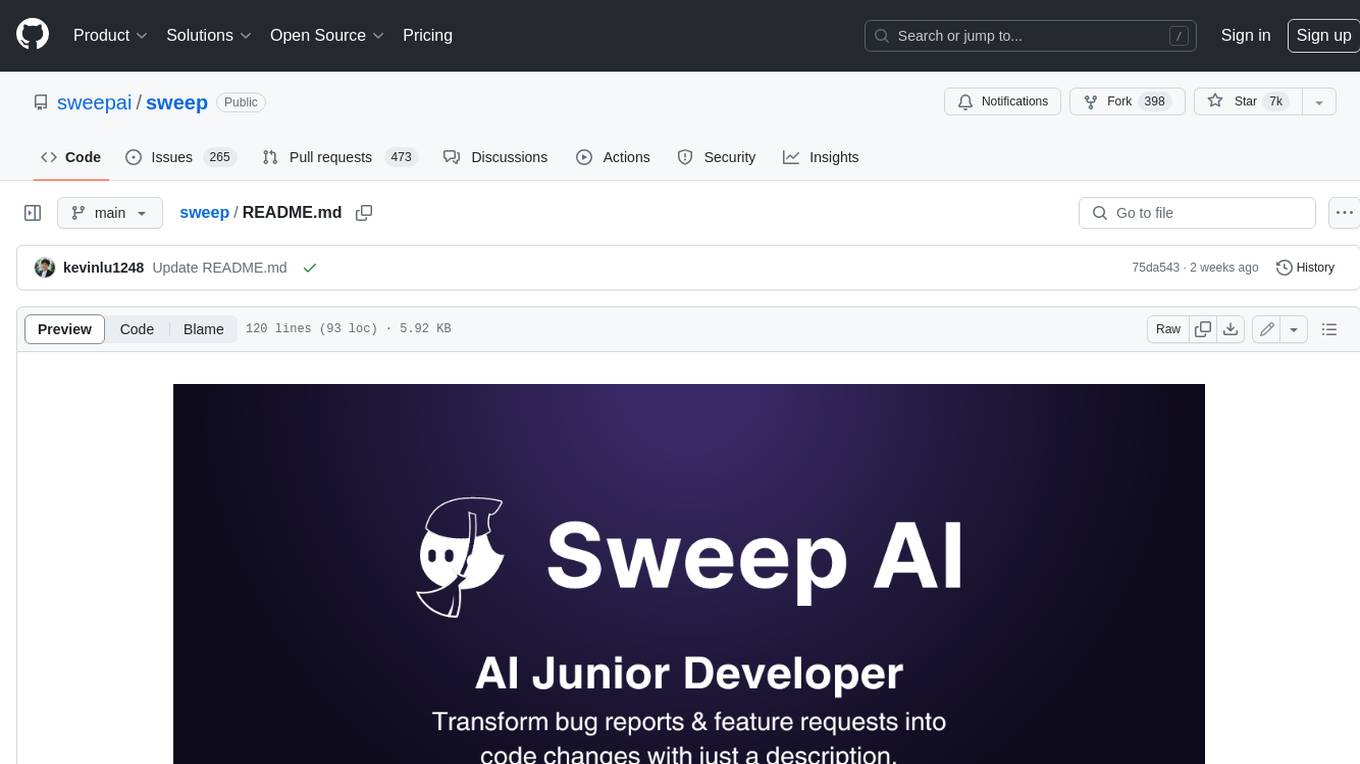
sweep
Sweep is an AI junior developer that turns bugs and feature requests into code changes. It automatically handles developer experience improvements like adding type hints and improving test coverage.
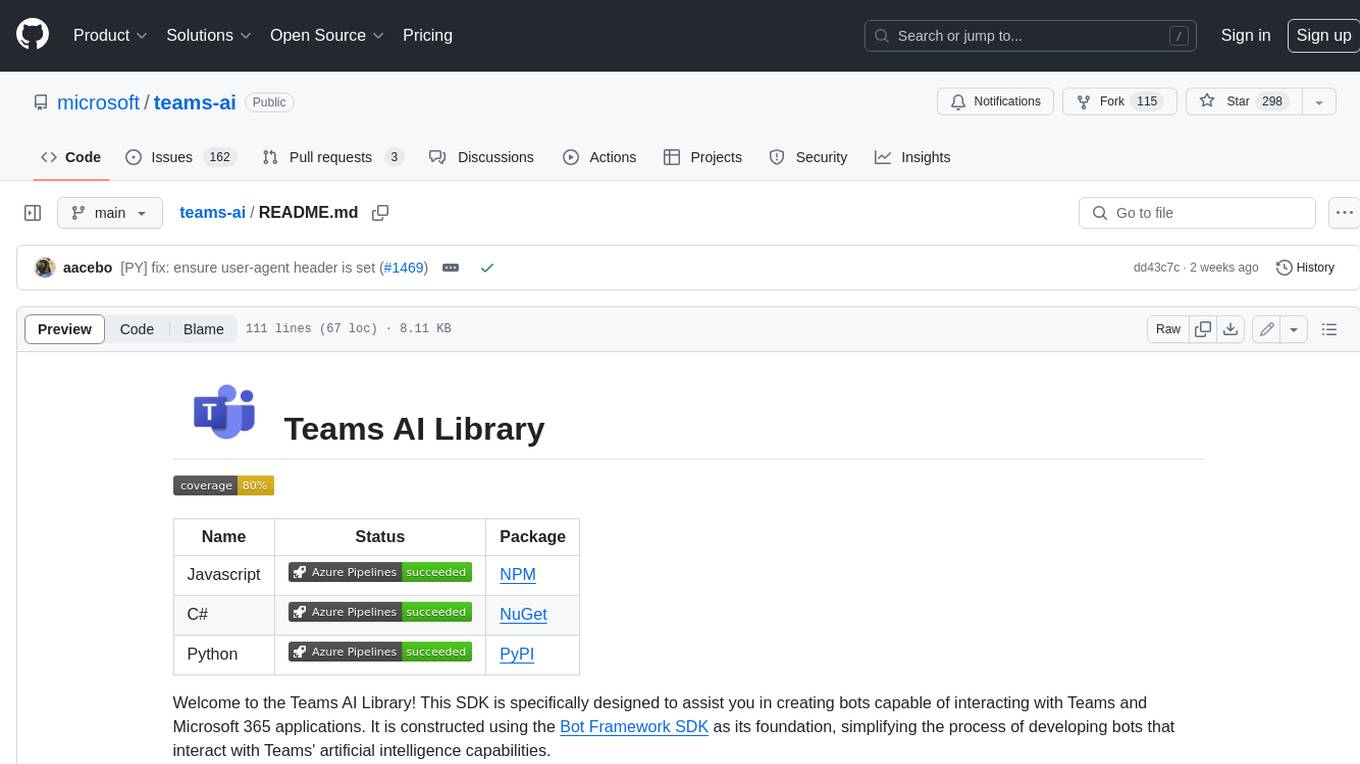
teams-ai
The Teams AI Library is a software development kit (SDK) that helps developers create bots that can interact with Teams and Microsoft 365 applications. It is built on top of the Bot Framework SDK and simplifies the process of developing bots that interact with Teams' artificial intelligence capabilities. The SDK is available for JavaScript/TypeScript, .NET, and Python.

ai-guide
This guide is dedicated to Large Language Models (LLMs) that you can run on your home computer. It assumes your PC is a lower-end, non-gaming setup.
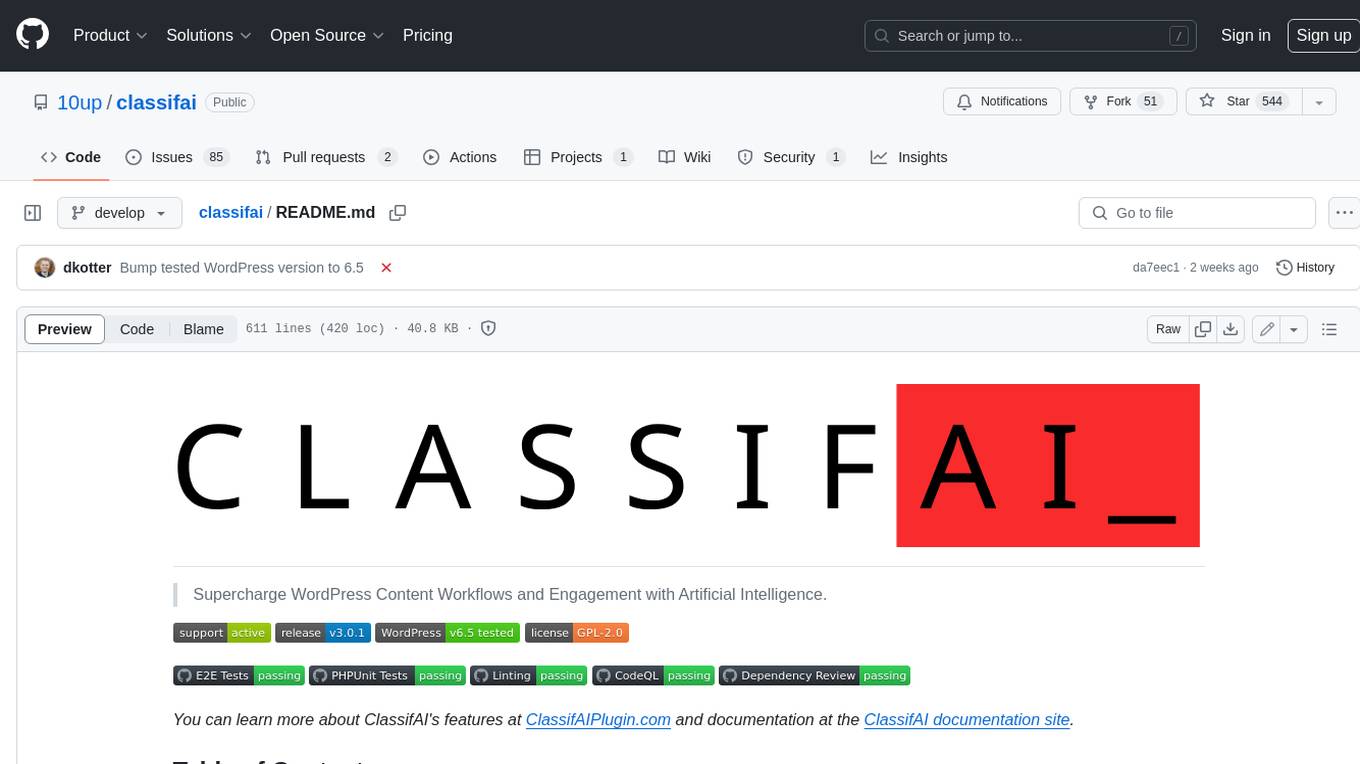
classifai
Supercharge WordPress Content Workflows and Engagement with Artificial Intelligence. Tap into leading cloud-based services like OpenAI, Microsoft Azure AI, Google Gemini and IBM Watson to augment your WordPress-powered websites. Publish content faster while improving SEO performance and increasing audience engagement. ClassifAI integrates Artificial Intelligence and Machine Learning technologies to lighten your workload and eliminate tedious tasks, giving you more time to create original content that matters.
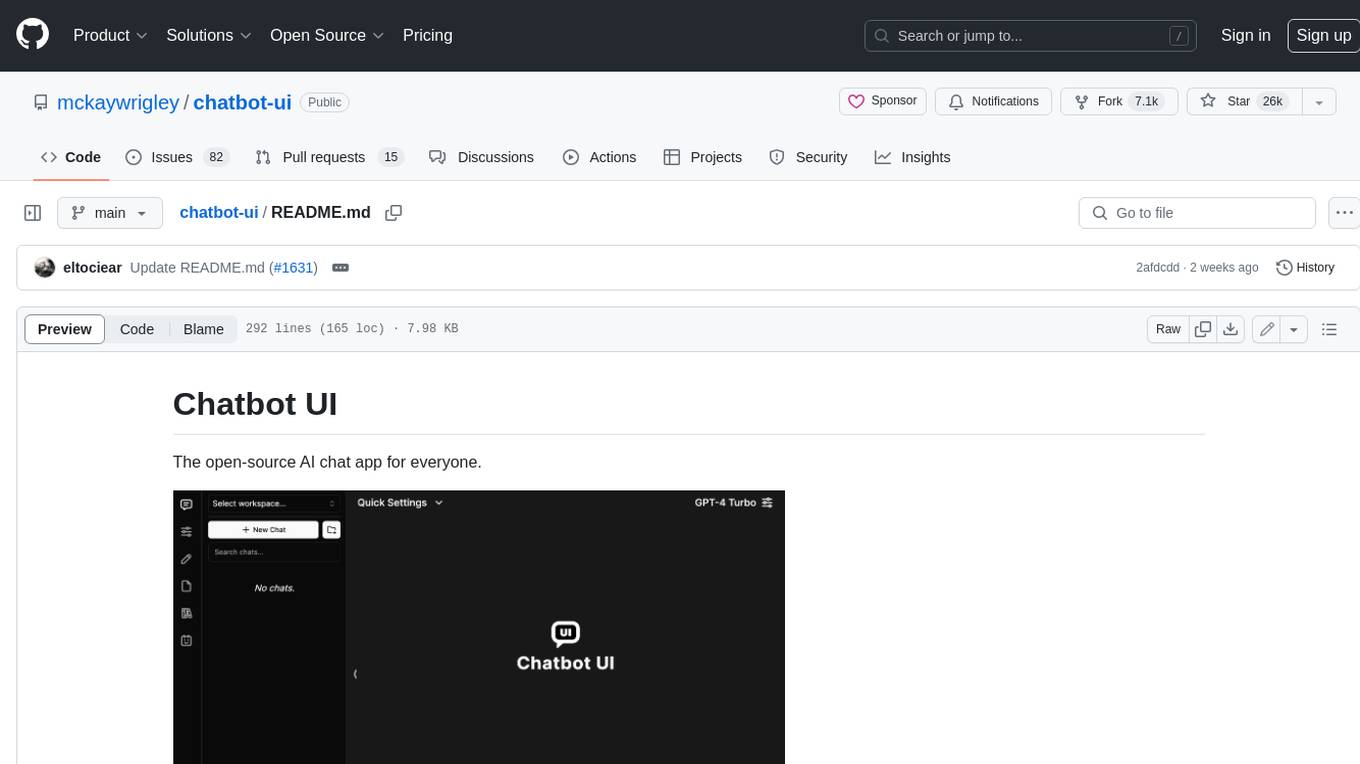
chatbot-ui
Chatbot UI is an open-source AI chat app that allows users to create and deploy their own AI chatbots. It is easy to use and can be customized to fit any need. Chatbot UI is perfect for businesses, developers, and anyone who wants to create a chatbot.
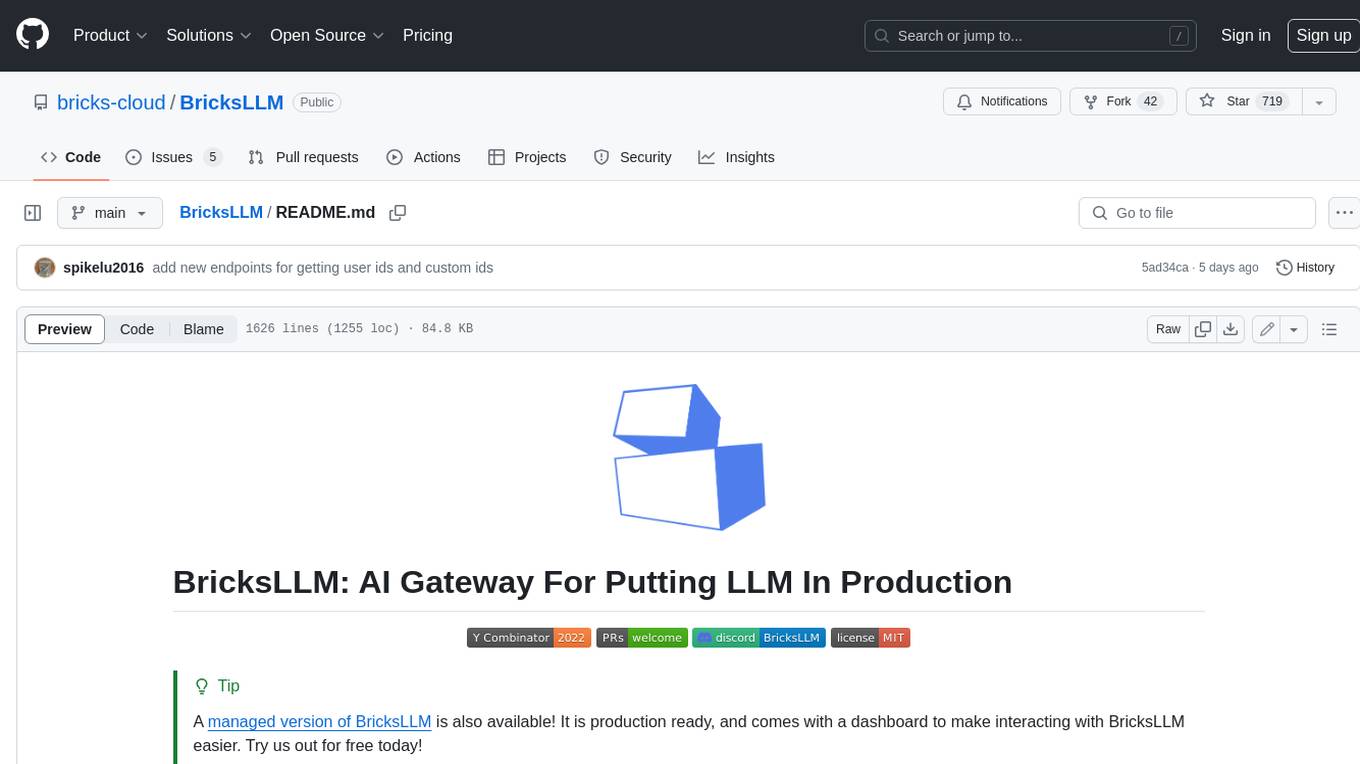
BricksLLM
BricksLLM is a cloud native AI gateway written in Go. Currently, it provides native support for OpenAI, Anthropic, Azure OpenAI and vLLM. BricksLLM aims to provide enterprise level infrastructure that can power any LLM production use cases. Here are some use cases for BricksLLM: * Set LLM usage limits for users on different pricing tiers * Track LLM usage on a per user and per organization basis * Block or redact requests containing PIIs * Improve LLM reliability with failovers, retries and caching * Distribute API keys with rate limits and cost limits for internal development/production use cases * Distribute API keys with rate limits and cost limits for students
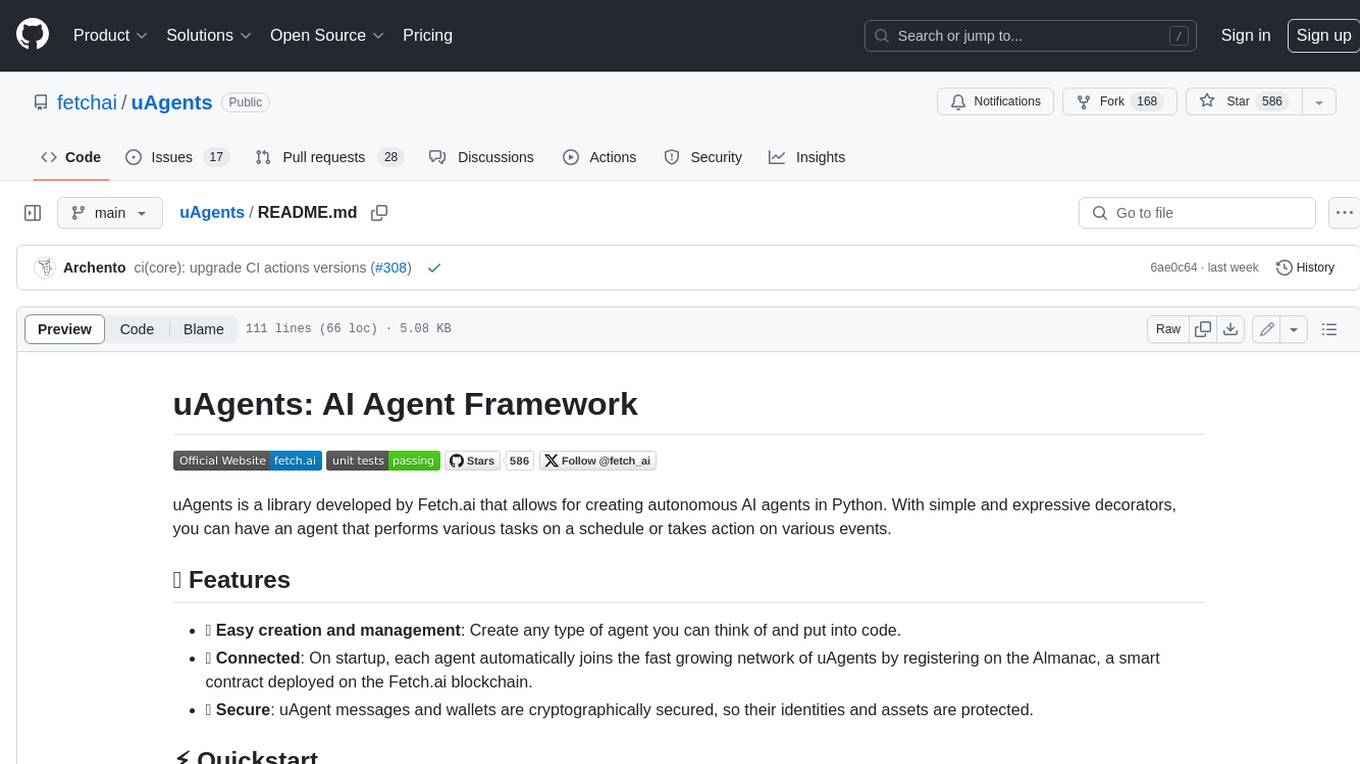
uAgents
uAgents is a Python library developed by Fetch.ai that allows for the creation of autonomous AI agents. These agents can perform various tasks on a schedule or take action on various events. uAgents are easy to create and manage, and they are connected to a fast-growing network of other uAgents. They are also secure, with cryptographically secured messages and wallets.

griptape
Griptape is a modular Python framework for building AI-powered applications that securely connect to your enterprise data and APIs. It offers developers the ability to maintain control and flexibility at every step. Griptape's core components include Structures (Agents, Pipelines, and Workflows), Tasks, Tools, Memory (Conversation Memory, Task Memory, and Meta Memory), Drivers (Prompt and Embedding Drivers, Vector Store Drivers, Image Generation Drivers, Image Query Drivers, SQL Drivers, Web Scraper Drivers, and Conversation Memory Drivers), Engines (Query Engines, Extraction Engines, Summary Engines, Image Generation Engines, and Image Query Engines), and additional components (Rulesets, Loaders, Artifacts, Chunkers, and Tokenizers). Griptape enables developers to create AI-powered applications with ease and efficiency.




